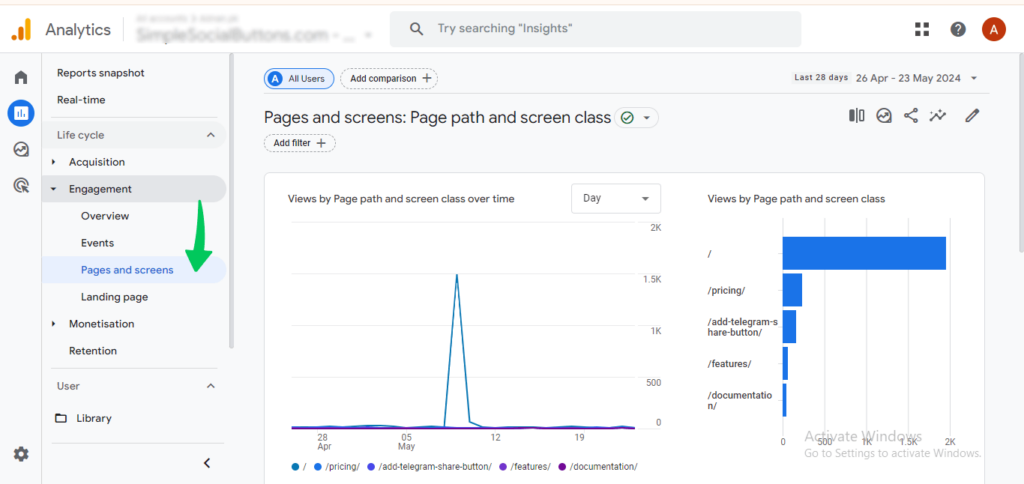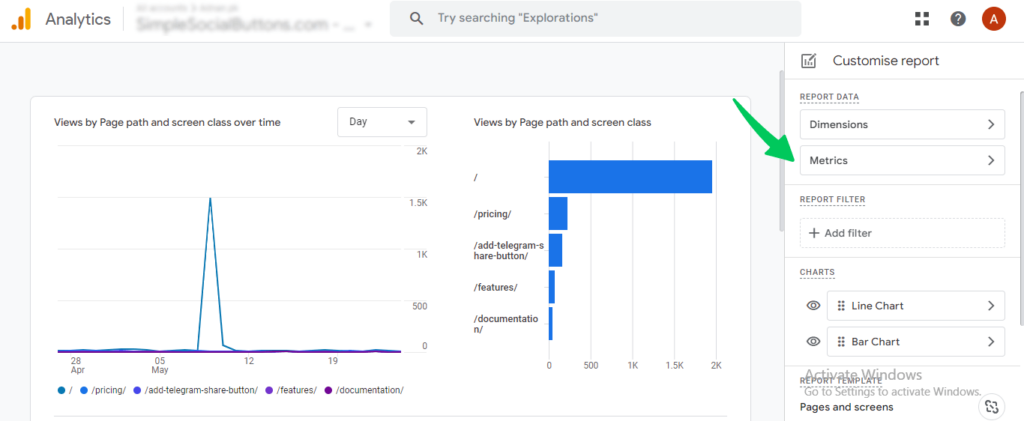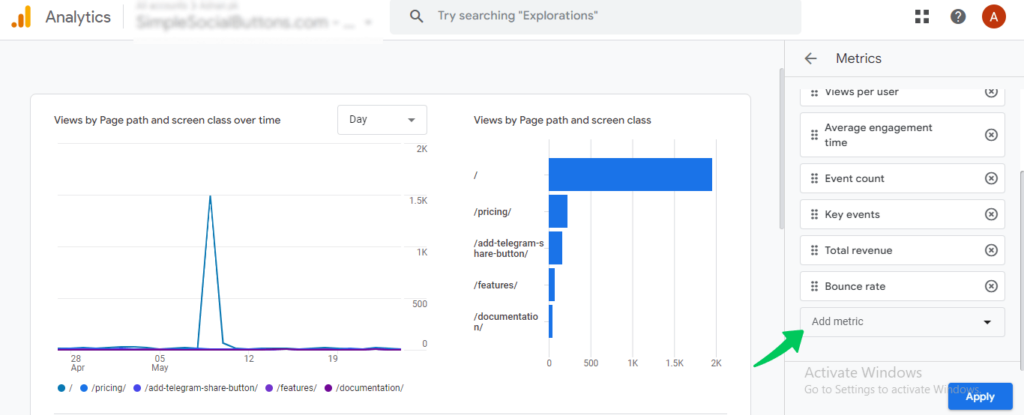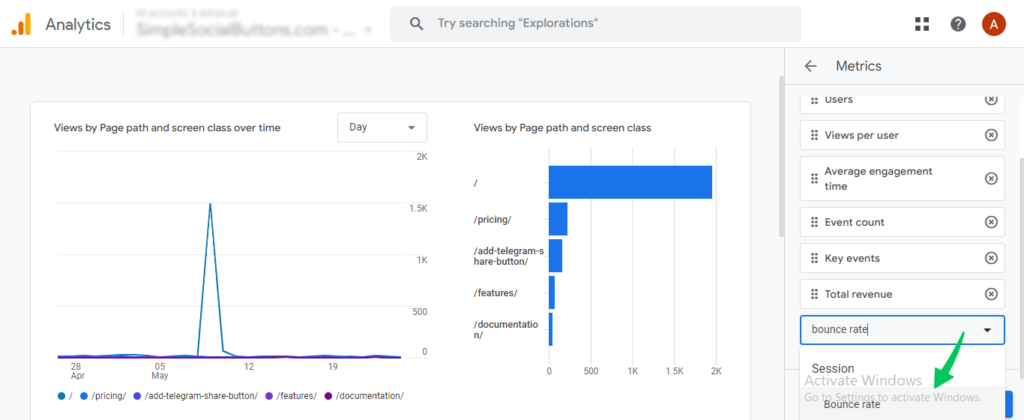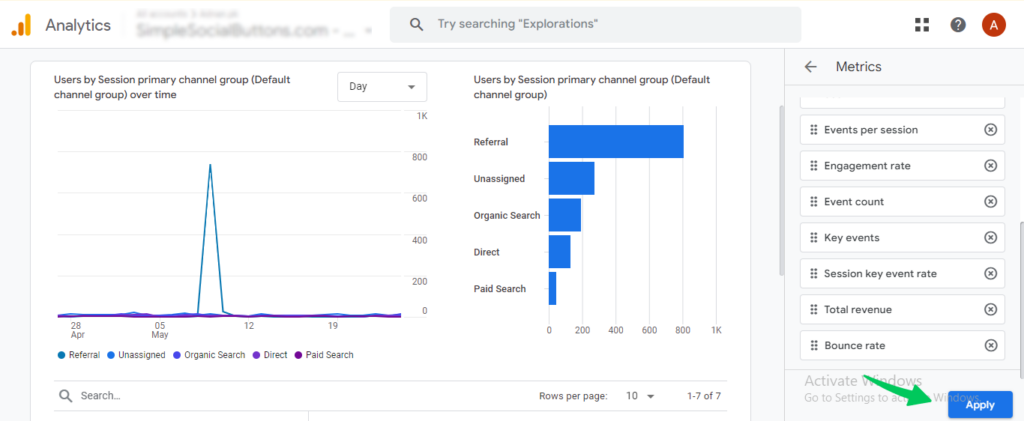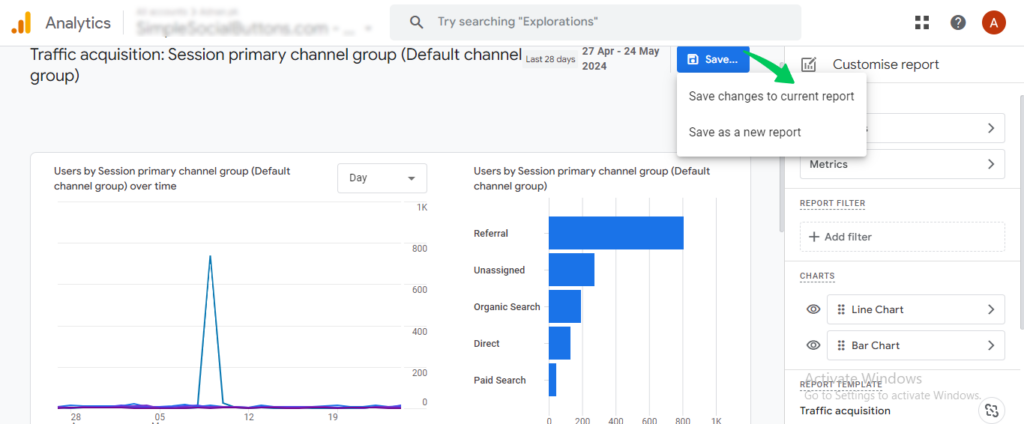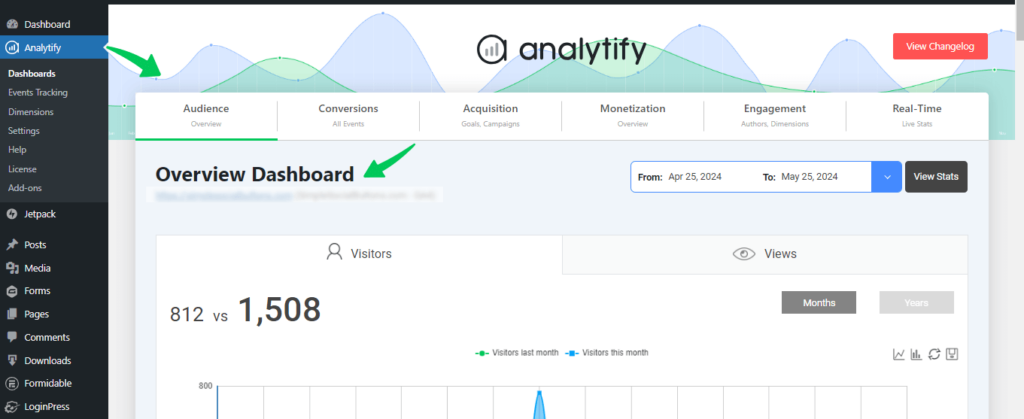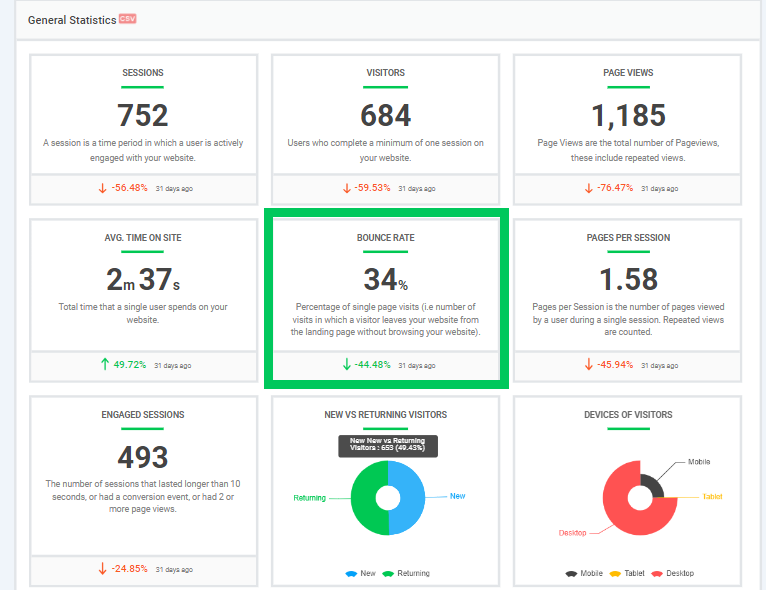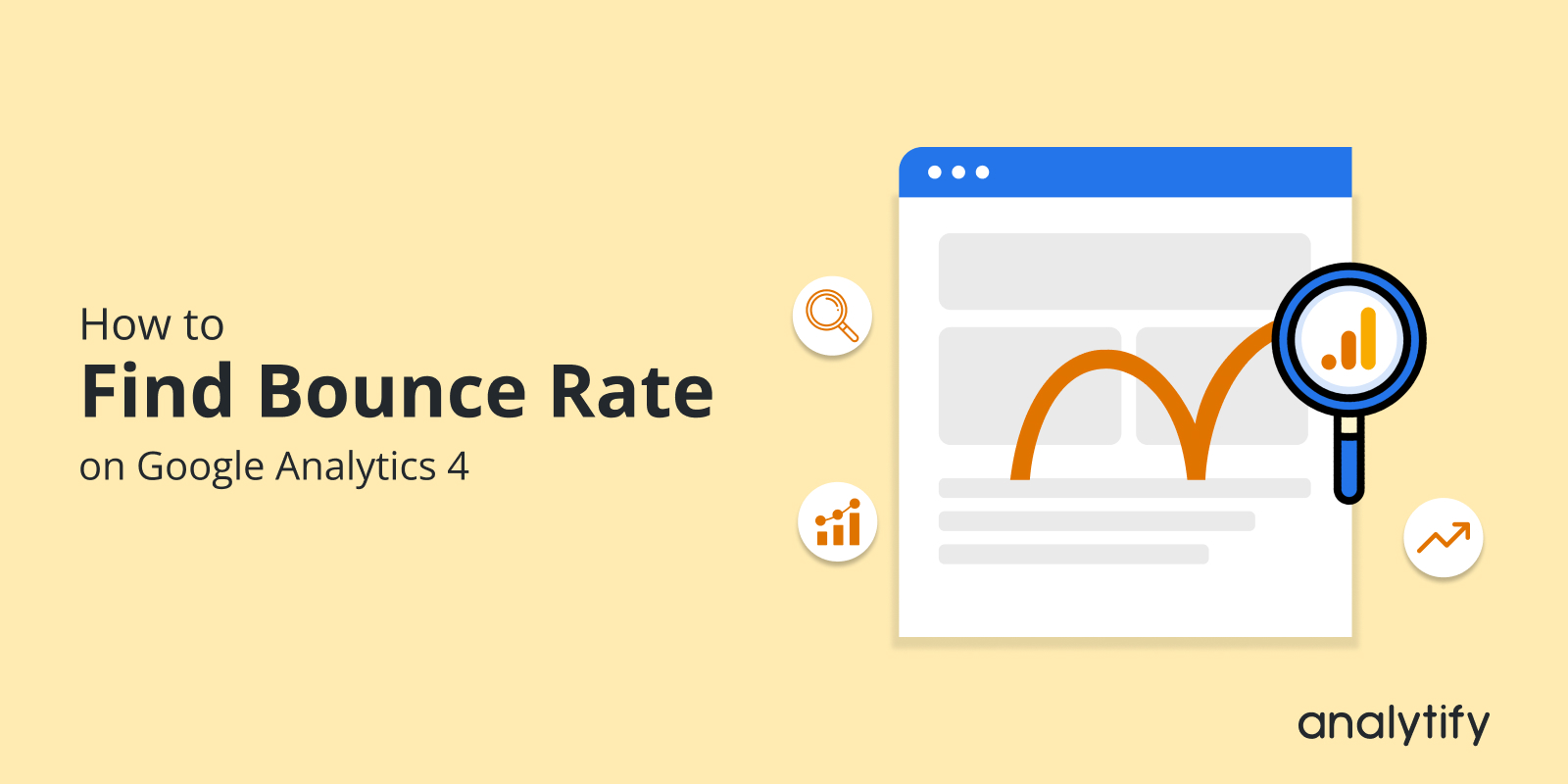
How to Find Bounce Rate on Google Analytics 4 (GA4)
Are you feeling lost in the world of Google Analytics 4 and need help finding the bounce rate in Google Analytics 4?
Bounce rate has long been a critical metric for determining the percentage of visitors who leave your site after viewing only one page.
However, with the shift to GA4, things have changed. The bounce rate isn’t prominently displayed anymore. Google Analytics 4 focuses on engaged sessions instead of bounce rate. However, you can still find bounce rates in Google Analytics 4.
In this article, we will discuss bounce rate, the difference between bounce rate in Universal Analytics (UA) and Google Analytics 4 (GA4), where is bounce rate in Google Analytics 4 and how to find bounce rate in Google Analytics 4.
Let us dive right into this insightful journey.
Bounce Rate in Google Analytics 4 (TOC):
What is Google Analytics Bounce Rate?
Bounce rate is a crucial metric in Google Analytics that reflects the percentage of visitors who leave your website after viewing only one page. In simpler terms, it tells you how many visitors landed on a single page and then exited without further interaction.
Imagine your website is a store. The bounce rate indicates the proportion of visitors who enter the store, browse just one aisle, and leave without making a purchase or exploring other sections.
A high bounce rate can signal several things:
- The landing page content might be irrelevant to the visitor’s search intent.
- The page might be slow to load, leading to frustration and abandonment.
- Navigation might be unclear, making it difficult for visitors to find what they want.
Understanding your bounce rate can provide valuable information about user engagement and identify areas for improvement on your website.
Difference between Bounce Rate in GA4 and UA
Universal Analytics ( UA ) is an older version of Google Analytics, which has been updated to Google Analytics 4.
The bounce rate is a metric traditionally used in web analytics to measure the percentage of single-page sessions in which users leave a website from the entrance page without interacting with it.
However, Universal Analytics (UA) and Google Analytics 4 (GA4) differ in how this metric is calculated and reported.
Bounce Rate in Universal Analytics (UA)
In Universal Analytics, the bounce rate is defined as:
“The percentage of sessions where users only visit a single page and trigger no additional requests to the analytics server.”
If a user lands on a page and then leaves without performing any other action (such as clicking on a link, submitting a form, or viewing another page), this session is considered a bounce.
High bounce rates can indicate issues with site content, user experience, or relevance of traffic sources.
How do you calculate the Bounce rate in Universal Analytics (UA)?
To calculate the bounce rate in Universal Analytics, use the following formula:
Bounce Rate = (Single Page Sessions ) / (Total Sessions) x 100
Where:
- Single-Page Sessions: The number of sessions during which users viewed only one page and triggered no additional requests.
- Total Sessions: This refers to the total number of visits to your website within a specific timeframe.
Interpreting Bounce Rate:
- A high bounce rate isn’t always negative. It depends on the context. For example, blog posts or informational pages may bounce higher as users get the information they need and leave without further interaction.
- Conversely, high bounce rates on product or checkout pages can indicate issues that need addressing.
Bounce Rate in Google Analytics 4 (GA4)
Google Analytics 4 approaches this metric differently. GA4 has introduced the “Engagement Rate“ which is essentially the inverse of the traditional bounce rate.
First of all, we will discuss about it:
“Engagement rate is a percentage of engaged sessions captured on your website.”
Instead of focusing on bounce rate, GA4 focuses on “engaged sessions”. An engaged session in GA4 has to meet this criteria:
- A session that lasts longer than 10 seconds
- has a conversion event
- has two or more page views.
So here, the GA4 bounce rate is defined as:
“ Percentage of sessions which are not engaged is called the GA4 bounce rate.”
Conditions are here that consider a session is bounce :
- A session that lasts less than 10 seconds.
- If a visitor triggers no conversion event during his visit.
- Sessions with only one page or screen view.
These are considered bounces unless one of the above criteria (session duration, conversion event, or Page view ) is met. A visitor who lands on a single page, spends more than 10 seconds, or completes a conversion will not be counted as a bounce.
How to Calculate the Engagement Rate in Google Analytics 4 (GA4)?
We can calculate the Engagement rate in Google Analytics 4 (GA4) by using this formula:
Engagement Rate = (Engaged Sessions/Total Sessions) × 100
How to Calculate the Bounce Rate in Google Analytics 4 (GA4)?
The bounce rate will be lower if the engagement rate is higher. To get a bounce rate in GA4, you can look at the complement of the engagement rate:
GA4 Bounce Rate=100% − Engagement Rate
Interpreting Engagement Metrics
Understanding and utilizing engagement metrics in GA4 provides a deeper understanding of user behavior. Instead of focusing solely on bounces, you can now analyze how effectively users are interacting with your site:
- Low Engagement Rate: Indicates potential content, user experience, or traffic quality issues.
- High Engagement Rate: Suggests that users find value and engage with your site or app.
By adopting this approach, GA4 allows you to make more informed decisions to enhance user experience, optimize content, and improve overall engagement.
Summary of Difference between Bounce Rate in UA and GA4
| Difference key points | Universal Analytics ( UA ) | Google Analytics 4 (GA4) |
| Definition: | Bounce Rate is based on single-page sessions with no further interactions. | Bounce Rate (not directly reported, but inferred) is based on the lack of an engaged session. |
| Engagement Criteria: | Any interaction or a visit to another page negates a bounce. | An engaged session is defined by more criteria (lasting longer than 10 seconds, conversion event, or multiple page views). |
| Focus on Engagement: | Focuses on what counts as a non-engagement (bounce). | Focuses on what counts as engagement, with more nuanced criteria. |
| Reporting Changes: | Bounce rate is a prominent metric. | The bounce rate is not directly reported; engagement metrics are more emphasized. |
| Actionable Insights: | High bounce rates can highlight pages that might be performing poorly or not meeting user expectations. | Engagement metrics provide a more comprehensive understanding of user interactions with low engagement, prompting a different approach to optimization. |
How to Find Bounce Rate on Google Analytics 4?
Remember the days of quickly spotting bounce rates in Universal Analytics? If you’ve migrated to GA4, then you know that GA4 doesn’t display bounce rates on the front anymore. However, this valuable data is still accessible and waiting to be discovered.
We’ll walk you through step-by-step instructions for adding bounce rate to standard reports in GA4. This will allow you to analyze user behavior and optimize your website for better results.
How to Add Bounce Rate in Google Analytics 4 Standard Reports?
Mostly bounce rate in GA4 reports isn’t included automatically, you must customize them to display this metric.
Pages and Screens Report
So, first of all, we move toward a step-by-step tutorial for adding bounce rate in pages and screen reports:
Step 1: Accessing the Report
Choose the “Reports” tab below the “Home” tab.

Step 2: Engagement Option
Select the “Engagement” option from the sidebar menu. Navigate to the specific report you want to analyze. From here, we’ll use the “Pages and screens” option.
Step 3: Customizing the Report
Click the “Pen” icon in the report window’s top right corner. This icon is for “Customize report”. This opens a sidebar where you can modify the data displayed.
Step 4: Adding Bounce Rate
In the “Report data” section of the sidebar, click on “Metrics”. Here, you’ll see a list of available metrics.
- Click on the bottom “ Add metric” option.
- Start typing “bounce rate”. Once it appears, select the “Bounce rate” metric.
Step 5: Choose Apply
The bounce rate will be added to the list of Metrics. Click the “Apply” button at the bottom of the sidebar.
Step 6: Saving the Customization
Click the “Save” button and choose “Save changes to current report.” It creates a personalized report with the added bounce rate metric.
Traffic Acquisition Report
Now, here is the step-by-step guide on how to find bounce rate in Google Analytics 4 for the Traffic Acquisition Report:
Step 1: Accessing the Report
Choose the “Reports” tab below the “Home” tab.
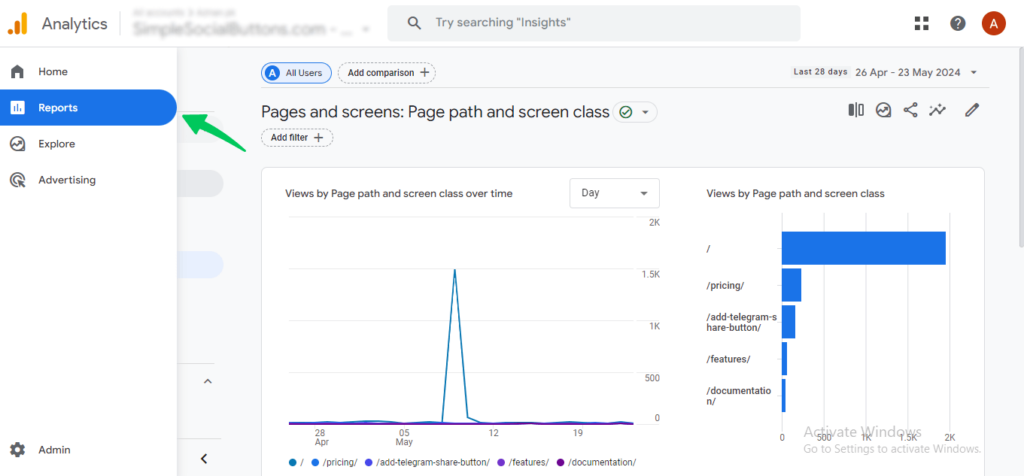
Step 2: Choose the Traffic Acquisition Report
Select the “ Acquisition ” Tab from the sidebar menu. We’ll use the “Traffic Acquisition” option from here.
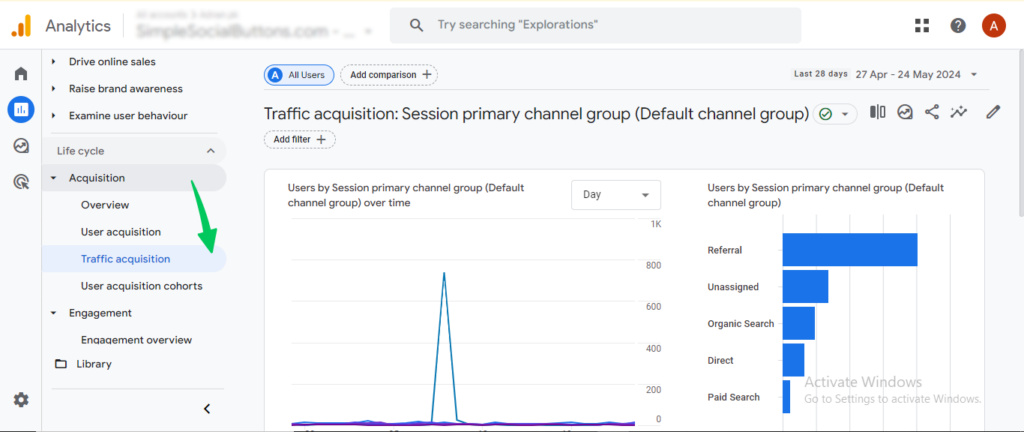
Step 3: Customizing the Report
Click the “Pen” icon at the top right corner of the report window. This icon is for “Customize report.” Clicking it opens a sidebar where you can modify the data displayed.
Step 4: Choose Metrics
In the “Report data” section of the sidebar, click on “Metrics”.
Step 5: Adding Bounce Rate
Here, you’ll see a list of available metrics. Click on the “ Add metric” option at the bottom.
- Start typing “bounce rate.” Once it appears, select the “Bounce rate” metric.
The bounce rate will be added to the Metrics list. Click the “Apply” button at the bottom of the sidebar.
Step 6: Saving the Customization
Click the “Save” button and choose “Save changes to the current report.” This will create a personalized report with a bounce rate.
By following these steps, you can reveal valuable insights about bounce rate within your desired GA4 reports. Remember, a lower bounce rate generally indicates a more engaged user experience.
How to Find Bounce Rate in WordPress?
In the previous section, we discussed about how to find bounce rate in Google Analytics 4. But what if you have a WordPress website and want to see the bounce rate in your WP dashboard? Great news! You can find the bounce rate in your WordPress dashboard and access all the other statistics for your website.
Analytify is the best Google Analytics plugin to help you view your website’s performance directly in the WordPress dashboard. Analytify is a one-stop solution for a holistic view of your website’s performance.
Join 50,000+ Beginners & Professionals who use Analytify to Simplify their Google Analytics!
It provides information about the number of visitors, page views, average time on site, bounce rate, engaged sessions, and much more.
How to Check Bounce Rate and Other Metrics in the Analytify Dashboard?
To check the bounce rate in the Analytify dashboard on your WordPress site, follow these steps:
1. Log in to Your WordPress Admin Panel
- Enter your username and password to access the WordPress dashboard.
2. Installation of Analytify
- From the left sidebar, click on the plugin tab. Choose “ Add new plugin.”
- Search Analytify in the search bar, install the Analytify plugin, and then activate it.
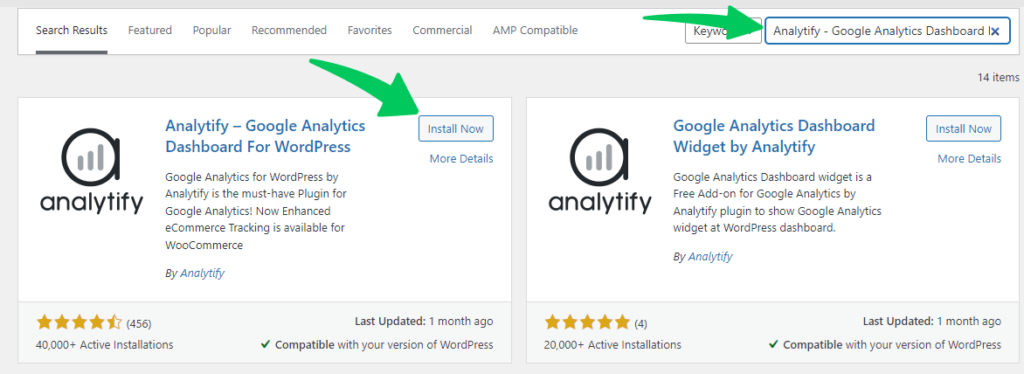
- For all the advanced features, install Analytify Pro.
2. Navigate to the Analytify Dashboard
- In the left-hand menu of your wp-admin, click on “Analytify.”
- This will open the Analytify dashboard.
3. View Your Dashboard
- On the Analytify dashboard, you will see various analytics reports.
- Look for the “Overview” or “Dashboard” tab where key metrics are shown.
4. Find the Bounce Rate
The overview section will show the bounce rate and other important metrics, such as sessions, users, page views, and average session duration.
GA4 Bounce Rate FAQs
1. What does bounce rate mean?
It is the percentage of website visitors who leave without visiting any other page or making any conversion after visiting only one page. There can be many reasons for a higher bounce rate. For example, if your homepage has a high bounce rate, users may not like your website design, your written content, or your content is boring.
2. Does Google Analytics 4 have a bounce rate metric?
In Google Analytics 4, the engagement rate is preferable to the bounce rate. So, here, the Bounce rate is the percentage of unengaged sessions. The bounce rate in Google Analytics 4 is calculated by dividing the number of unengaged sessions by the total number of sessions.
3. What is a good engagement rate in Google Analytics?
The “Good” engagement rate varies based on the nature of the product, the industry type, and the target audience. According to experts, a good engagement rate is between 1% and 5% on most social media platforms and between 60% and 70% on websites and online businesses.
4. Where is bounce rate in Google Analytics 4?
You have to follow the following steps to view the GA4 bounce rate:
First, select Reports from the left menu. Then, select the report you want to customize. After that, Click on Customize report in the upper-right corner of the report. In the Report data section of the right panel, click on Metrics. Here, Add “Bounce rate” and click on Apply.
5. What is a reasonable bounce rate in Google Analytics?
Usually, a bounce rate of 40% or lower is considered good, and a bounce rate of 55% or higher is considered not good. This shows that improvements are required to increase user engagement. However, most websites have an average bounce rate of 26% and 70%, depending on your industry, content types, channels, traffic source, and other factors.
Bounce Rate in Google Analytics 4: Final Thoughts
In conclusion, with our step-by-step guide, you can easily find the bounce rate in GA4. However, learning the difference between bounce rate in Universal Analytics and Google Analytics 4 is essential. Now, you’ve mastered the art of bounce rate in GA4.
Remember, it’s a metric that reflects how engaging your website is to visitors. So, the Bounce rate is just one piece of the puzzle. Look at engagement time, conversion rates, and other metrics to get a holistic view of website performance. Now go forth and create an engaging online experience that keeps visitors coming back for more!
This journey doesn’t end here. Explore the vast potential of WordPress plugins like Analytify to view website performance metrics directly within your dashboard for even greater convenience.
What is your preferred analytics metric for understanding your website’s performance? Please let us know your choice in the comments section below.

